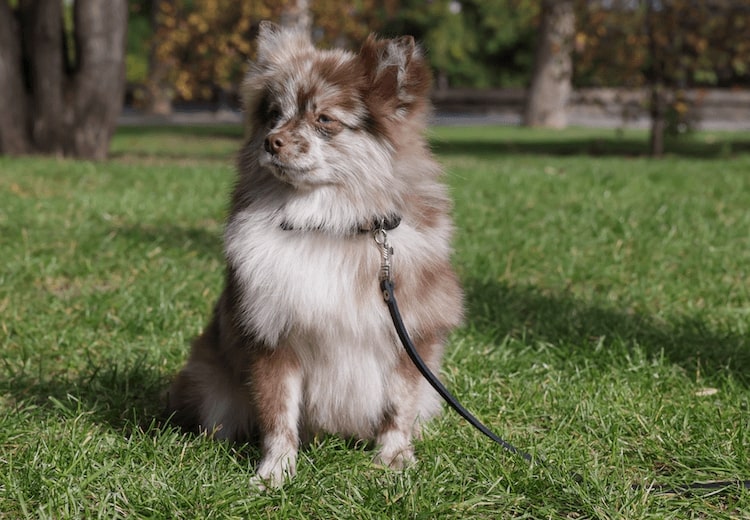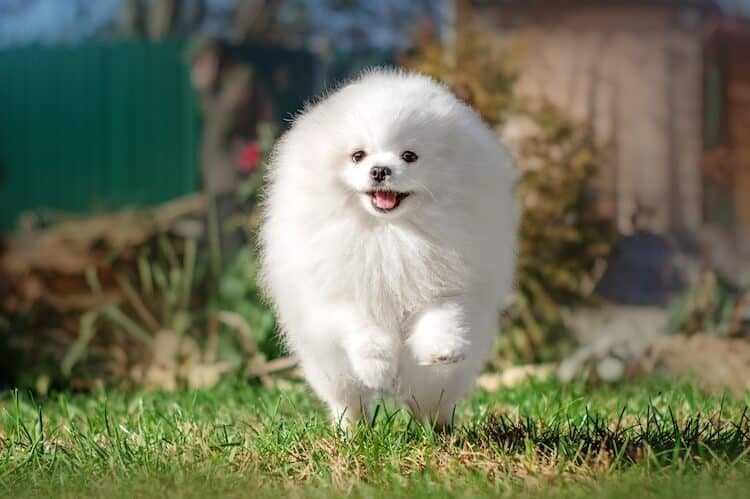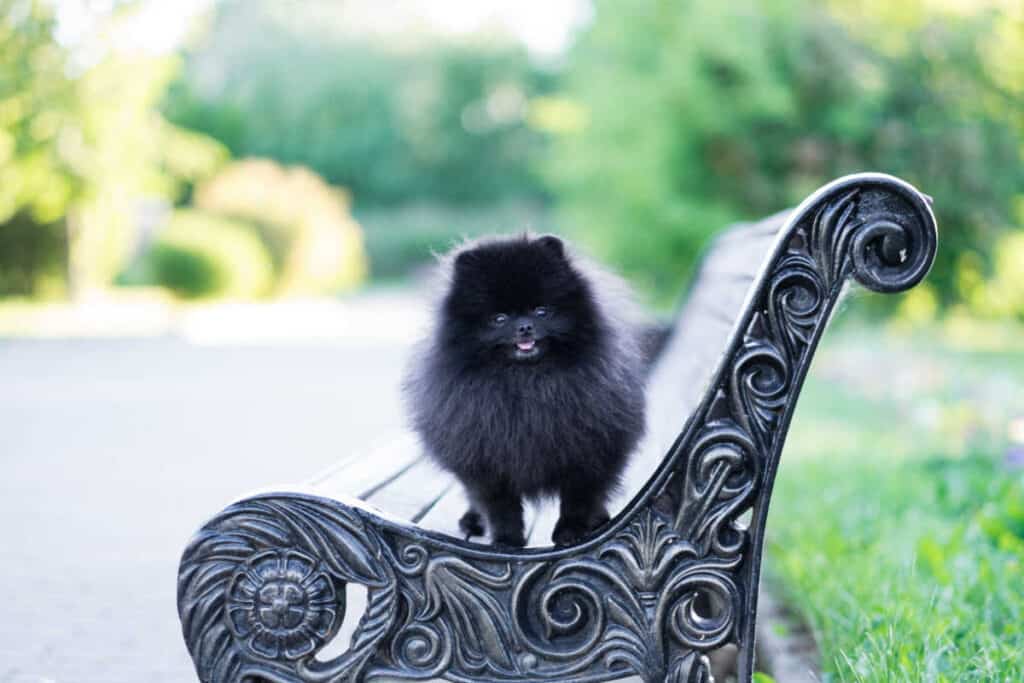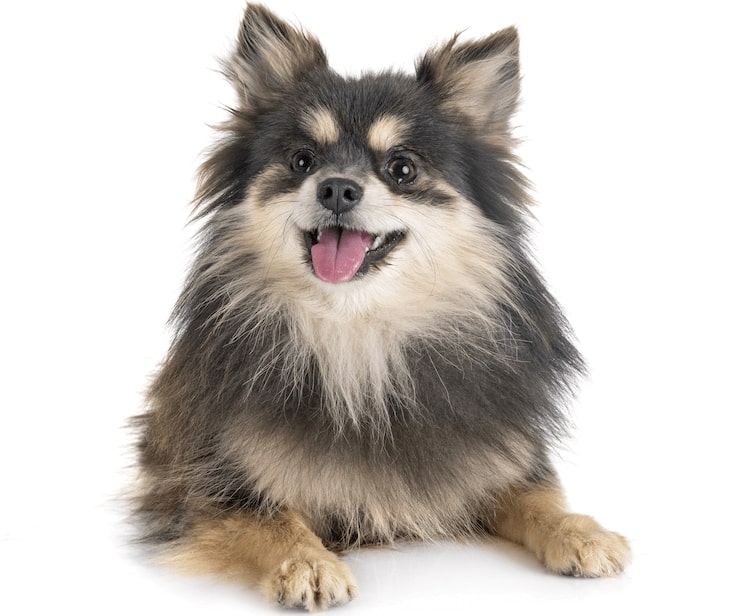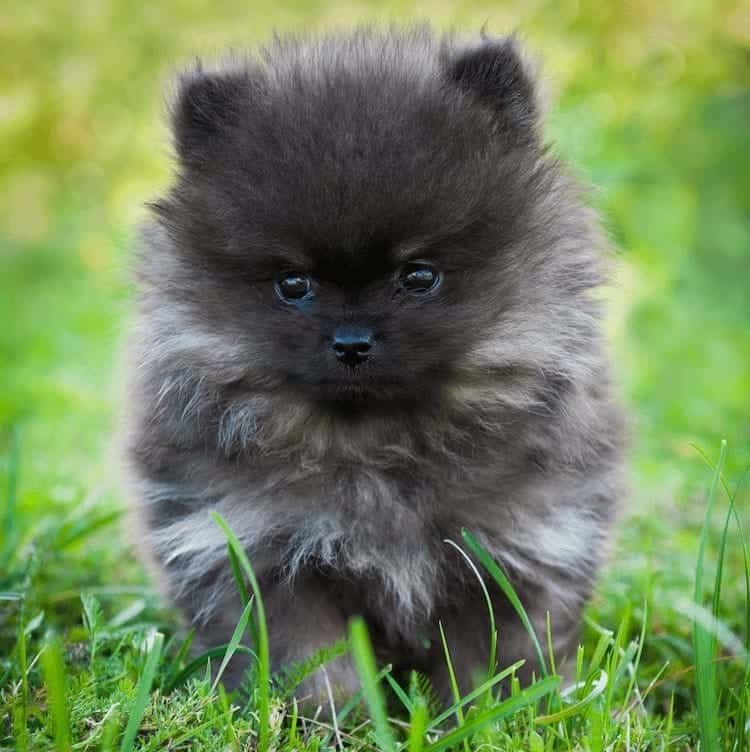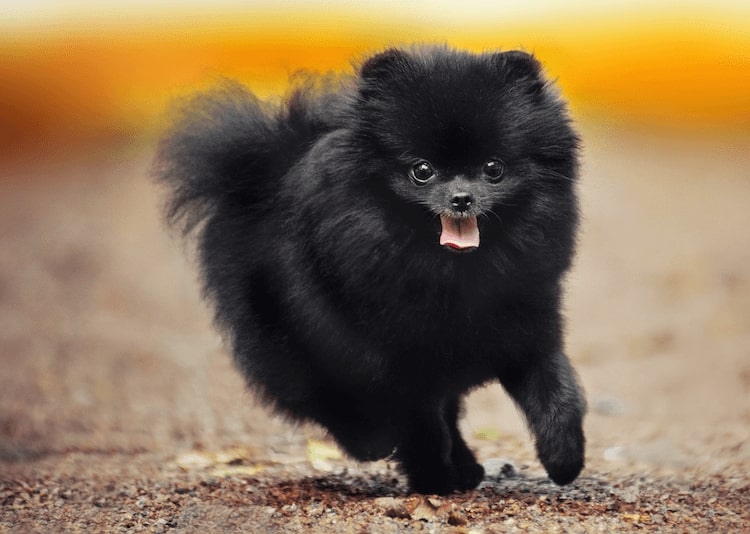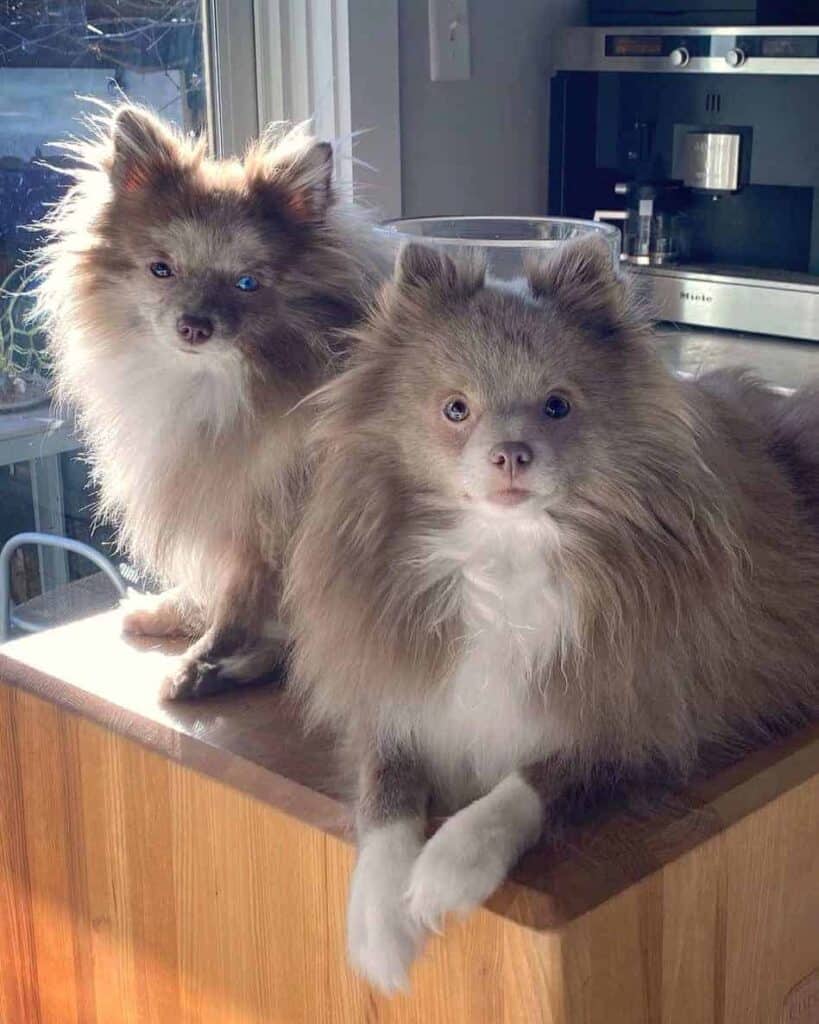Pomeranian is one of the most popular dog breeds in the USA. It ranks 14th among the 155 breeds registered by the American Kennel Club. This small breed is an excellent choice for people who don’t have a lot of time to give to their pets. They are fairly independent and get along well with older and calm people.
Despite having tiny bodies, Pomeranians often exhibit a big-dog demeanor. They are alert and intelligent and can be trained to be brilliant watchdogs. This toy dog barks a lot and may sometimes challenge larger dogs.
Pomeranians, also called the Poms, have a distinguishing fluffy double coat and foxy face. They are also easily recognized by the thick and luxurious ruff around their neck and chest.
Pomeranian comes in an array of colors ranging from white to black and many other shades in between. There are 25 colors and patterns of Pomeranian, including 9 solid coat colors and 16 combinations.
Coat colors, like orange, cream, tan, and chocolate, are quite common, while some other color varieties are harder to breed.
Here we list 8 of the rarest Pomeranian color that exists. The popularity rank mentioned for each type of Pomeranian is based on individual surveys and not any official record.
8. Beaver
Appearance: Dilute chocolate ranging from light biscuit to dark brownish gray with a silver-blue cast
Point color: Light-colored
Popularity rank: 20

photo source: gampomclub.org
The coat color we know as Beaver today was earlier called ‘Biscuit’. It is a rare color for Pomeranians. The color ranges from light orange-brown to brownish gray. It is caused by the dilution gene working on a chocolate brown coat.
The Beaver Pomeranian also features silvery-blue coat tips. One of the distinguishing features of the Beaver Pomeranian is its self-colored skin pigmentation around the eye rims, nose, lips, and paw pads. The points are light-colored.
Cream or Chocolate Pomeranians are often confused with Beaver. However, a Beaver will never have a black nose or black in his coat. If a Pomeranian has a black nose, be assured that it is definitely not a Beaver.
Did you know?
Pomeranian got its name from the Pomerania region located in north-east Germany and north-west Poland.
7. Chocolate Merle
Appearance: Chocolate coat color with the merle pattern
Point color: Pink and black speckles on nose and paw pads (usually)
Popularity rank: 19

photo source: www.marvelousdogs.com
Merle is not a color. It is a pattern that creates mottled patches on the coat color. Pomeranians with chocolate coats and merle patterning are known as Chocolate Merle. It is a rare combination for Pomeranians and highly sought after in the US.
However, this color pattern is disqualified by many European kennel clubs, including Fédération Cynologique Internationale (FCI).
It requires careful breeding to produce a healthy Chocolate Merle or any Merle in general. Besides, it should always be remembered that two merles must not be bred together. It may produce sick puppies with several health issues.
Merle pattern can be seen on any base coat color and produce Blue Merle, White Merle, or Red Merle Pomeranian.
Did you know?
The blotches that appear on the coat do not follow an order. They are completely random, and that makes every Chocolate Merle Pomeranian unique.
6. White
Appearance: Solid white with no other shades
Point color: Black
Popularity rank: 6

photo source: www.marvelousdogs.com
White Pomeranian appears snow white without any marking or color. It is extremely difficult to get a pure white Pomeranian. Both their guard hairs and undercoats are white. It is one of the original breed colors.
The color of their eyes is very dark and often black. They have black points, which means they have black noses, black eye rims, black lips, and black pads. At birth, they have pink points that get darker as they mature.
Pomeranian puppies may often appear white at birth. However, they turn into Cream or Orange as they grow up.
Did you know?
Queen Victoria bought four Pomeranians from Italy in the late 1800s; one of them was white. However, she decided to keep only the Red one. That made Red Pomeranian incredibly popular. Before this, the White Pomeranian was much more widespread than other varieties.
5. Blue
Appearance: Diluted black
Point color: Blue
Popularity rank: 16

photo source: hellobark.com
Although it is called the Blue Pomeranian, the color is more on the grayish side, a watered-down shade of black. It is a solid coat color without any markings. A Blue Pomeranian can appear dark gray, silver, or a shade of grayish-blue. They have grayish-blue guard hair and a gray undercoat.
Some Blue Pomeranians can appear so dark that they can be mistaken as black. However, the eye rims, nose, and paw pads of a Blue Pomeranian will always be blue and not black.
Blue Pomeranians usually appear silver when they are born. Later, as they mature, they develop silver or gray undercoat and darker outer coat. A Blue Pomeranian can be produced by breeding two Black Pomeranians.
Did you know?
Fédération Cynologique Internationale (FCI) has determined that Pomeranian has come from German Spitz, a much larger breed. In some countries, Pomeranian is known as the “Dwarf Spitz” (Zwergspitz).
4. Blue and Tan
Appearance: Solid blue coat color with tan markings
Point color: Blue
Popularity rank: 18

photo source: www.marvelousdogs.com
Blue Pomeranians with rust or tan markings are known as Blue and Tan Pomeranians. Tan marking appears on three base coat colors, Blue, Brown, and Black. The Blue and Tan combination is the rarest among all three types, while Black and Tan is the most popular one.
A Blue Pomeranian will have tan markings on its muzzle and above the eyes. The marking is also visible on the chest, throat, legs, paws, and below the tail.
The distribution of marking patterns is the same for all three types of tan-marked Pomeranians. Blue Pomeranians with rich tan marks are more desirable than the Pomeranians with lighter tan marks.
Did you know?
Blue and Tan Pomeranians are born only when two copies of the recessive bb genes are there. In order to produce Blue and Tan Pomeranian, both parents must carry a blue and tan gene.
3. Wolf Sable
Appearance: Gray undercoat with darker gray guard hair
Point color: Black
Popularity rank: 15

photo source: www.marvelousdogs.com
Wolf Sable Pomeranians are extremely rare to find. They can feature various shades of gray, from silvery white to light gray. The guard hair comes with black tipping. Their eye rims, nose, lips, and paw pads are always black. They also have lighter ‘spectacles’ around their eyes.
A Wolf Sable Pom must not have any hint of orange in its coat color. Sometimes breeders register Orange Pomeranians as Wolf Sable because they often appear gray at birth. As the puppy matures, the orange color comes through.
Did you know?
Two Pomeranians survived the Titanic disaster. Their owners carried them in their laps/cradles while climbing into the lifeboats.
2. Black
Appearance: Jet black undercoat and guard hairs
Point color: Black
Popularity rank: 5

photo source: www.marvelousdogs.com
A Black Pomeranian will have gorgeous black guard hairs and a fluffy black undercoat. They do not have markings. Their eye rims, nose, claws, and pads are also completely black.
They are always pure jet-black with no white, red, or brownish fur. However, a Black Pomeranian may have one or two strands of white hair around its chest. They carry a gene that is responsible for producing black pigments.
Black Pomeranian is here since this breed was first bred in the Pomerania region. In the 17th century, they were pretty common and easy to breed. However, it has become exceedingly rare with the emergence of new colors and years of crossbreeding.
Did you know?
The fur color of a Black Pomeranian may turn red or brown as they mature. It mainly happens due to exposure to the sun.
1. Lavender
Appearance: Greyish blue with pinkish chocolate hue
Point color: Chocolate
Popularity rank: 23

photo source: www.bubblypet.com
Lavendar is the rarest Pomeranian color. Although it is called Lavendar, the actual color is silvery brown or grayish with a tinge of pinkish chocolate. They could be easily mistaken as Light Hair Chocolate Pomeranians.
Lavender Pomeranian also goes by other names such as Lilac Pomeranian, Isabella Pomeranian, or Diluted Chocolate Pomeranian.
The color is caused by the presence of two rare dilute genes. The same dilute gene is responsible for creating Blue Pomeranian. When this gene works on the black coat color, the dog becomes blue, and when it combines with the Chocolate coat, it results in Lavender. It is 100% purebred. It is produced when two purebred Pomeranians carrying the dilute genes breed.
Although in the popularity index Lavendar Pomeranian ranks low, this particular variety is highly-priced because of its rarity.
Did you know?
AKC doesn’t recognize Lavendar as a standard base color for Pomeranian. It is the only solid color for Poms that is not listed by AKC. So, if you want to register your Lavendar Pomeranian with them, you will have to list them under the Chocolate Pomeranian category.


